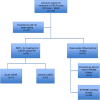Photodynamic therapy for central serous chorioretinopathy
- PMID: 24946843
- PMCID: PMC4135258
- DOI: 10.1038/eye.2014.134
Photodynamic therapy for central serous chorioretinopathy
Abstract
Purpose: Central serous chorioretinopathy (CSCR) is an idiopathic disorder characterised by detachment of the neurosensory retina due to serous fluid accumulation between the photoreceptor outer segments and the retinal pigment epithelium. There are currently no set guidelines or protocols on its treatment. This study was undertaken to assess the current literature on the the efficacy and safety of photodynamic therapy (PDT) as a treatment option for CSCR.
Methods: Seven databases (PubMed, CENTRAL, MEDLINE, Web of Science, Embase, Scopus, and The Cochrane Database of Systematic Reviews) were searched without restrictions on time or location. We followed PRISMA guidelines and evaluated quality according to STROBE criteria. In total, 117 citations were identified and 31 studies describing 787 eyes were included for review. Data on indications for PDT in CSCR, dosing regimens of verteprofin PDT (which includes treatment dose of vertoporfin, treatment time, fluence, and spot size), number of treatment sessions, response to treatment, mean length of follow-up, and complications were extracted and analysed.
Results: Since the introduction of PDT for the treatment of CSCR in 2003, there have been three randomised controlled trials (RCTs), one for acute and two chronic CSCR and 28 further studies that met the STROBE criteria that compared the use of PDT with other treatment options. All studies showed short-term efficacy of PDT in CSCR. The studies were of small sample size and lacked sufficient follow-up to draw conclusions on long-term efficacy and safety.
Conclusions: There is sufficient scientific evidence to suggest that PDT may be a useful treatment option for chronic CSCR in the short-term. The review identifies a need for robust RCTs with longer follow-up to ascertain the role of PDT as a useful treatment option for CSCR.
Figures
References
-
- Gass JDM. Pathogenesis of disciform detachment of the neuroepithelium. II. Idiopathic central serous choroidopathy. Am J Ophthalmol. 1967;63:587–615. - PubMed
-
- Maumenee AE. Symposium: Macular diseases. Clinical manifestations. Trans Am Acad Ophthalmol Otolaryngol. 1965;69:605–613. - PubMed
-
- von Graefe A. Kurzere Abhandlungen, Notizen and casuistische Mittheilungen vermischten Inhalts. VI. Ueber centrale recidivirende Retinitis Albrecht von Graefes. Arch Ophthalmol. 1866;12 (Pt. II:2115.
-
- Ferrara DanielaC, Calucci Daniela, Oréfice Juliana, Magalhães ÉrikaP, Oréfice Fernando, Costa RogerioA. Proposed physiopathological mechanisms and potential therapeutic targets for central serous chorioretinopathy. Expert Rev Ophthalmol. 2008;3 (5:553–565.
Publication types
MeSH terms
LinkOut - more resources
Full Text Sources
Other Literature Sources
Miscellaneous


